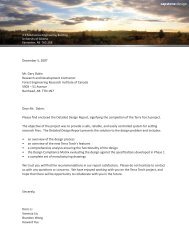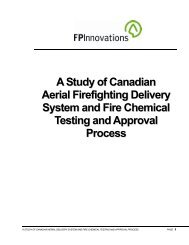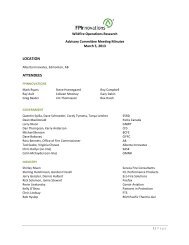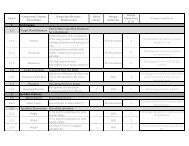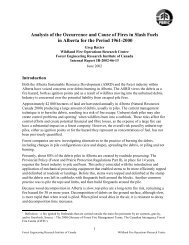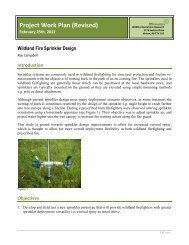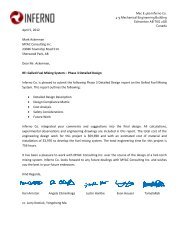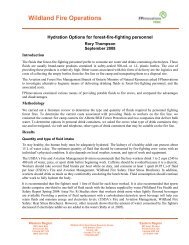Report: Chisholm wildfire entrapment investigation - FPInnovations ...
Report: Chisholm wildfire entrapment investigation - FPInnovations ...
Report: Chisholm wildfire entrapment investigation - FPInnovations ...
Create successful ePaper yourself
Turn your PDF publications into a flip-book with our unique Google optimized e-Paper software.
FIRE CREW DEPLOYMENT<br />
Applies to Personnel employed by the Forest Service and involved in ground fire<br />
suppression operations.<br />
Purpose To provide a safe work environment and to meet Workers’<br />
Compensation Board Occupational Health & Safety Regulations.<br />
The Forest Service will have Safe Work Standards that constitute safe<br />
methods, conditions and requirements for workers involved in fire line<br />
suppression operations.<br />
Critical Safety Statement Regular and auxiliary Protection staff will be trained in and practise<br />
avoidance of circumstances that may require a fire shelter<br />
deployment.<br />
Exceptions If conditions call for deviation from these standards, an amending<br />
written practise will be developed to address the specific situation and<br />
ensure the safety of personnel. The appropriate Fire Centre Manager or<br />
the Director must approve this practise.<br />
Contact Dave Tweedhope: Dave.tweedhope@gems8.gov.bc.ca or (250) 554 5533<br />
PROCEDURES<br />
Fire Shelters<br />
All regular and auxiliary staff assigned to active fireline duties will be<br />
trained in the use of and will carry approved fire shelters.<br />
Supervisors will ensure untrained and unequipped personnel are not<br />
exposed to conditions that require use of a fire shelter during fireline<br />
duties.<br />
Personnel required to carry approved fire shelters will receive adequate<br />
training annually on the correct use of fire shelters.<br />
Strategies and<br />
Tactics<br />
Fire shelters will be inspected at least once a month for wear holes and<br />
overall integrity. Faulty shelters will be immediately taken out of service<br />
and replaced.<br />
Strategies for attacking a fire will incorporate predicted fire behaviour in<br />
order to minimize the risk to workers. The Incident Commander or his<br />
designate must approve any deviations from daily crew assignments.<br />
Fire work areas will have at least one and preferably two scouted escape<br />
routes. Escape routes will be communicated to all crew members and<br />
will be continually assessed for suitability. Helipads/helicopters will not<br />
be considered as primary escape routes.<br />
If no escape route can be identified, alternative attack strategies MUST<br />
be incorporated to ensure crew safety. When there is the potential for<br />
extreme fire conditions (fire intensity class greater than Intensity Class<br />
4), the Incident Commander will appoint a lookout whose primary task<br />
will be to monitor fire behaviour and potential threats. Escape routes and<br />
weather monitoring will be undertaken hourly.<br />
Page 51 of 61



